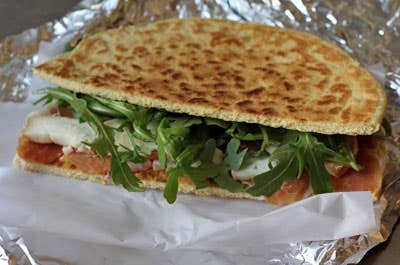
The Cult of Piadina: Emilia-Romagna’s Exquisitely Rustic Flatbread Sandwich
I didn't grow up loving sandwiches the way some people do. Quick lunctime PB&J's and 2 a.m. post-party medianoches at Cuban diners in Miami - I viewed the food as mundane, a source of physical nourishment rather than a culinary wonder. It took a move to Italy for me to realize how truly great a sandwich could be. After spending a few months living Bologna, my boyfriend Marco took me to his hometown on the Romagnolan coast. There, he inducted me into the cult of the piadina.
We were at a tiny kiosk somewhere between Russi and Ravenna, nestled among peach groves and swathes of bare farmland. Inside, a piadinaro was churning out sandwiches served on a biscuit-like flatbread called a piadina. (See the recipe.) Marco advised me to start with the classic Romagnolan version in which two halves of a piadina contain a filling of soft, unaged squaquerone cheese, prosciutto, and spicy wild arugula.
After I placed my order with the piadinaro, he got to work: he pulled a fistful of raw bread dough from a huge vat on the counter and ran it through a machine where two metal spools flattened it into a perfect round. It went onto a hot iron griddle, where it began to bubble and rise, taking on the bread's characteristic brown speckles and filling the room with a sweet, yeasty smell. While the bread cooked, the piadinaro hauled an enormous leg of prosciutto to the slicer, and shaved off gossamer-thin pieces. He cut the piadina in half. A slathering of cheese on one half of the fresh-grilled bread, a delicate layer of prosciutto, and a handful of crisp arugula to crown it, another piadina half on top and my sandwich was done.
After my first piadina, I was hooked. I could understand why the sandwiches are objects of obsession in Emilia-Romagna. Poets have rhapsodized about their sublime flavor and the meditative ritual of their preparation: "Behold it is smooth as paper and/as big as the moon," wrote a nineteenth-century Italian poet, Giovanni Pascoli, in a work entitled "La Piada." The country piadinari in Emilia-Romagna are not merely fast-food cooks, but torchbearers for a deep and meaningful culinary legacy. The principal piadinaro in Marco's hometown of Russi dropped out of law school to open his own piadina kiosk, knows by heart how most of his customers like their sandwiches, and closely guards his special recipe for the dough.
A few years after my first piadina episode - and six months after Marco and I had both moved to New York City - we started experiencing serious withdrawal. A vain search of the city revealed not a single place that treated the dish with as much attention and respect as piadina makers in Italy. When our cravings reached a fever pitch, we decided that we would have to become expert piadinari ourselves.
As many an immigrant can attest, the hardest thing about recreating a location-specific dish in a foreign country is finding the right ingredients. Marco's mother's recipe for piadine called for type 00 flour, which is a finely ground specialty flour usually used for making pizza dough and bread. We searched for the flour in a few grocery stores before finding King Arthur Flour 00 (Antico Caputo 00 flour is also a good choice). After some debate, we made some basic substitutions to the recipe. It called for lard, which we changed to vegetable shortening. When piadine are made at home, they are typically cooked on a terracotta press, but since we wanted to recreate the piadine we had eaten at the country kiosks, we decided to use a cast-iron griddle.
When the dough was rested and ready, we simply imitated what we had seen so many piadina-makers doing back in Italy. Our rounds of dough sizzled on the hot griddle, and after arranging the filling — we used sweet San Daniele prosciutto, sharp semi-firm taleggio, and arugula — we sat down to eat. I bit into the warm, flaky piadina sandwich. We hadn't recreated the exact kiosk piadina— probably because we had skipped the animal fat, our version was denser and less greasy than the original. But in carrying the Romagnolan tradition into new territories, our piadina might be worthy of a few poems too.
Keep Reading
Continue to Next Story










